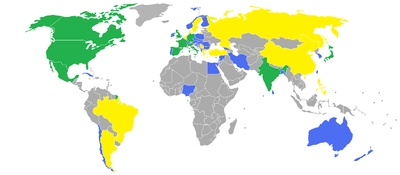World cinema

| World cinema |
|---|
World cinema is a term used primarily in English-speaking countries to refer to the films and film industries of non-English-speaking countries. It is therefore often used interchangeably with the term foreign film. However, both world cinema and foreign film could be taken to refer to the films of all countries other than one's own, regardless of native language.[1]
Definition
Technically, foreign film does not mean the same as foreign language film, but the inference is that a foreign film is not only foreign in terms of the country of production, but also in terms of the language used. As such, the use of the term foreign film for films produced in the United States, United Kingdom, Australia, Canada or other English-speaking countries would be uncommon within other English-speaking countries.
World cinema has an unofficial implication of films with "artistic value" as opposed to "Hollywood commercialism." Foreign language films are often grouped with "art house films" and other independent films in DVD stores, cinema listings etc. Unless dubbed into one's native language, foreign language films played in English-speaking regions usually have English subtitles. Few films of this kind receive more than a limited release and many are never played in major cinemas. As such the marketing, popularity and gross takings for these films are usually markedly less than for typical Hollywood blockbusters. The combination of subtitles and minimal exposure adds to the notion that "World Cinema" has an inferred artistic prestige or intelligence, which may discourage less sophisticated viewers. Additionally, differences in cultural style and tone between foreign and domestic films affects attendance at cinemas and DVD sales.[1]
Foreign language films can be commercial, low brow or B-movies. Furthermore, foreign language films can cross cultural boundaries, particularly when the visual spectacle and style is sufficient to overcome people's misgivings. Films of this type became more common in the early 2000s, as Crouching Tiger, Hidden Dragon, Amélie, Brotherhood of the Wolf, Y Tu Mama Tambien and Talk to Her enjoyed great successes in United States cinemas and home video sales. The first foreign and foreign language film to top the North American box office was Hero in August 2004.[2]
On DVD
Foreign language films that are particularly successful in international markets may be taken on by the large film distribution companies for DVD releases. At the other end of the scale, many foreign language films are never given a DVD release outside of their home markets. The majority of those DVDs that are given an international release, come out on specialist labels. These labels include:
- Arrow Films (UK) - Label specialising in foreign language and cult English language films
- Artificial Eye (USA and UK)
- Axiom Films (UK)
- British Film Institute (UK)
- Contender Entertainment Group - Label distributing East Asian films. They bought out Medusa Communications in 2005, and own the sub-labels Hong Kong Legends (specialising in films from Hong Kong) and Premier Asia (specialising in films from the rest of East Asia, particularly Japan, South Korea and Thailand). CEG bought out the label.
- The Criterion Collection (USA)
- Dragon Dynasty (USA) - Label specialising in films from East Asia.
- Eastern Eye (Australia)
- Facets Multimedia (USA)
- Film Movement (USA)
- Fortissimo Films (Netherlands / international)
- ImaginAsian Pictures (USA)
- Janus Films (USA)
- Kino International (USA) - Label distributing foreign language, arthouse and silent films.
- Manga Entertainment (USA and UK) - Label specialising in anime.
- Masters of Cinema (UK)
- Mongrel Media (Canada)
- Optimum Releasing (UK) - Distributor of foreign and English language films in the UK. East Asian films released through their Optimum Asia sub-label.
- Palador Pictures (India) - Distributors of highly awarded foreign language films from across the world.
- Palisades Tartan (USA and UK) - Palisades bought out the back catalogue of Tartan Films when they folded.
- Soda Pictures (UK)
- Studio Canal (France)
- Tartan Films (USA and UK) - Label distributing a variety of foreign and English language films, though primarily East Asian films. The company consists of Tartan Video in the UK and Tartan Films USA, as well as the Tartan Asia Extreme and Tartan Terror horror labels. The company folded in 2008 and were taken over by Palisades.
Television channels
- CinéMoi (UK channel dedicated to French films)
- UTV World movies (India)
- NDTV Lumiere (India)
- World Movies (Australia)
- CinemaWorld (Singapore)
See also
- Eurocinema
- Jutra Award
- Dhaka University Film Society
- List of cinema of the world
- Academy Award for Best Foreign Language Film
- César Award for Best Foreign Film
- World Fastest Movie
- History of film
- Transnational cinema
- World Cinema Foundation
- Muslim Cinema
- Film industry
- World music
Footnotes
- 1 2 Curran, Daniel. Foreign Films: More than 500 films on video cassette, pages v-vi. Evanston, Illinois: CineBooks, 1989.
- ↑ Brandon Gray (August 29, 2004). "'Hero' Soars to Late August Record". boxofficemojo.com.